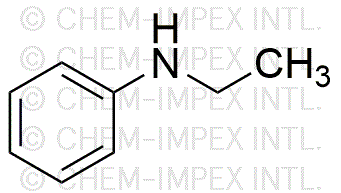N-Ethylaniline is widely utilized in research focused on:
- Dyes and Pigments: It serves as an intermediate in the production of various dyes, particularly in the textile industry, enhancing colorfastness and vibrancy.
- Pharmaceuticals: This compound is used in the synthesis of active pharmaceutical ingredients, contributing to the development of medications for various health conditions.
- Agrochemicals: N-Ethylaniline plays a role in creating herbicides and pesticides, helping to improve crop yields and protect against pests.
- Polymer Production: It is involved in the manufacture of certain polymers and resins, which are essential in creating durable materials for construction and packaging.
- Research and Development: This compound is frequently used in laboratories for chemical synthesis and as a building block in organic chemistry, facilitating innovative research projects.
General Information
Properties
Safety and Regulations
Applications
N-Ethylaniline is widely utilized in research focused on:
- Dyes and Pigments: It serves as an intermediate in the production of various dyes, particularly in the textile industry, enhancing colorfastness and vibrancy.
- Pharmaceuticals: This compound is used in the synthesis of active pharmaceutical ingredients, contributing to the development of medications for various health conditions.
- Agrochemicals: N-Ethylaniline plays a role in creating herbicides and pesticides, helping to improve crop yields and protect against pests.
- Polymer Production: It is involved in the manufacture of certain polymers and resins, which are essential in creating durable materials for construction and packaging.
- Research and Development: This compound is frequently used in laboratories for chemical synthesis and as a building block in organic chemistry, facilitating innovative research projects.
Documents
Safety Data Sheets (SDS)
The SDS provides comprehensive safety information on handling, storage, and disposal of the product.
Product Specification (PS)
The PS provides a comprehensive breakdown of the product’s properties, including chemical composition, physical state, purity, and storage requirements. It also details acceptable quality ranges and the product's intended applications.
Certificates of Analysis (COA)
Search for Certificates of Analysis (COA) by entering the products Lot Number. Lot and Batch Numbers can be found on a product’s label following the words ‘Lot’ or ‘Batch’.
*Catalog Number
*Lot Number
Certificates Of Origin (COO)
This COO confirms the country where the product was manufactured, and also details the materials and components used in it and whether it is derived from natural, synthetic, or other specific sources. This certificate may be required for customs, trade, and regulatory compliance.
*Catalog Number
*Lot Number
Safety Data Sheets (SDS)
The SDS provides comprehensive safety information on handling, storage, and disposal of the product.
DownloadProduct Specification (PS)
The PS provides a comprehensive breakdown of the product’s properties, including chemical composition, physical state, purity, and storage requirements. It also details acceptable quality ranges and the product's intended applications.
DownloadCertificates of Analysis (COA)
Search for Certificates of Analysis (COA) by entering the products Lot Number. Lot and Batch Numbers can be found on a product’s label following the words ‘Lot’ or ‘Batch’.
*Catalog Number
*Lot Number
Certificates Of Origin (COO)
This COO confirms the country where the product was manufactured, and also details the materials and components used in it and whether it is derived from natural, synthetic, or other specific sources. This certificate may be required for customs, trade, and regulatory compliance.


